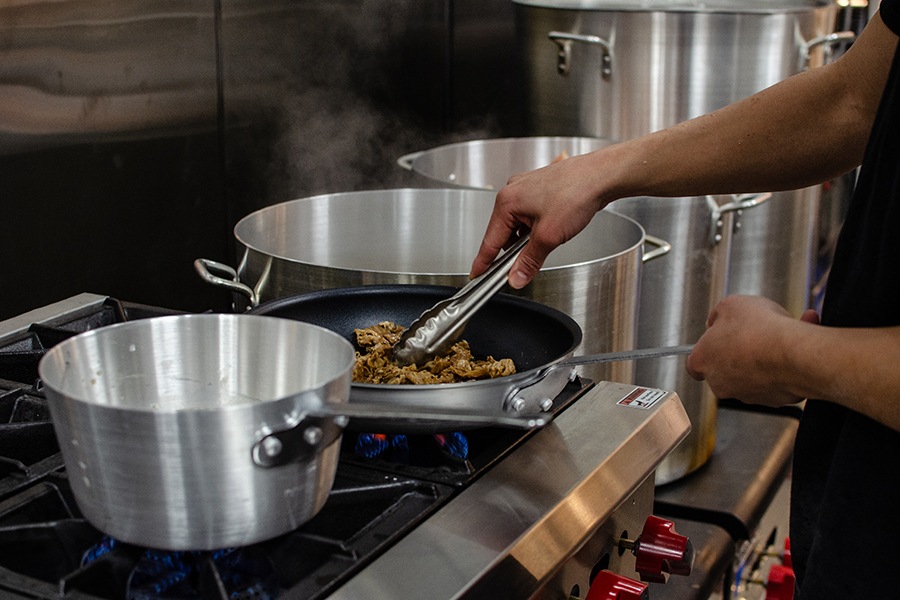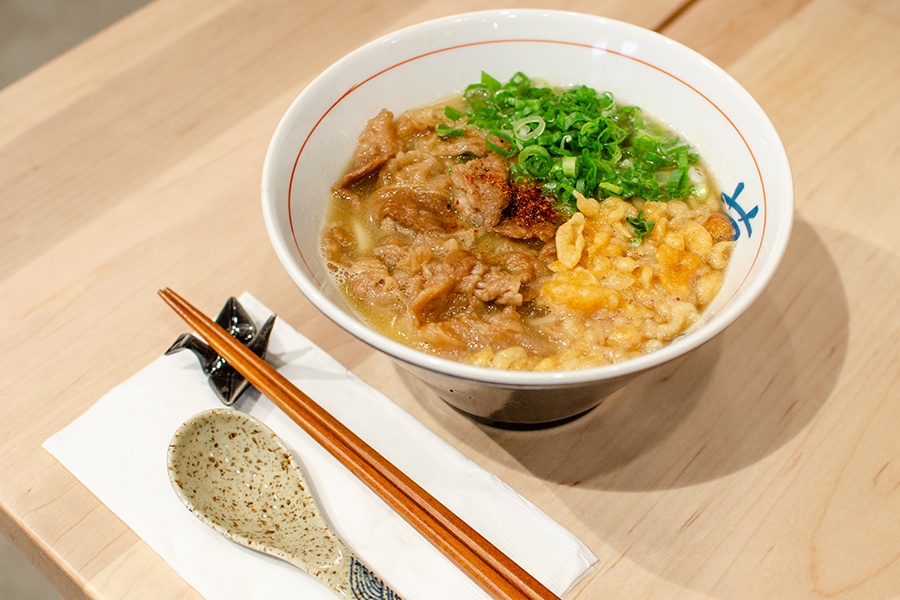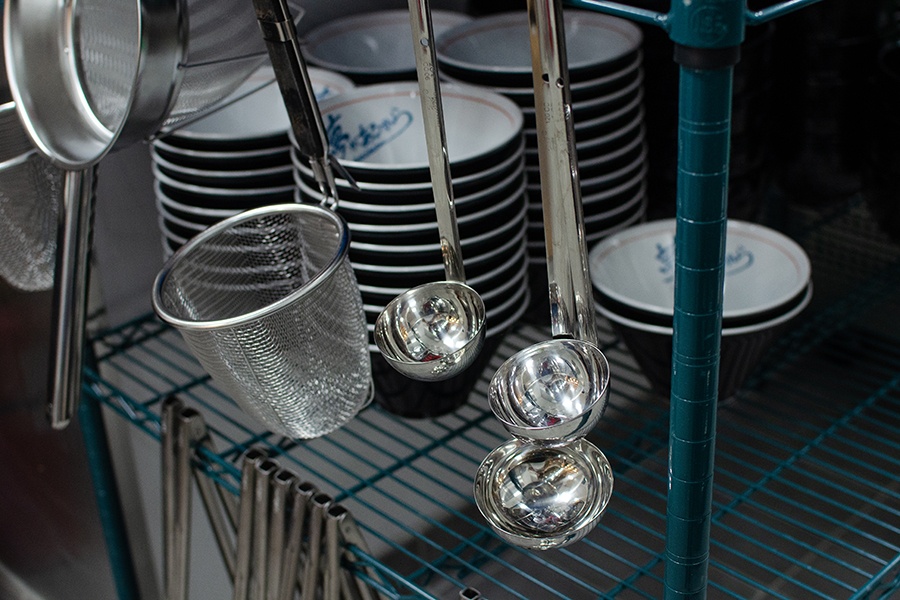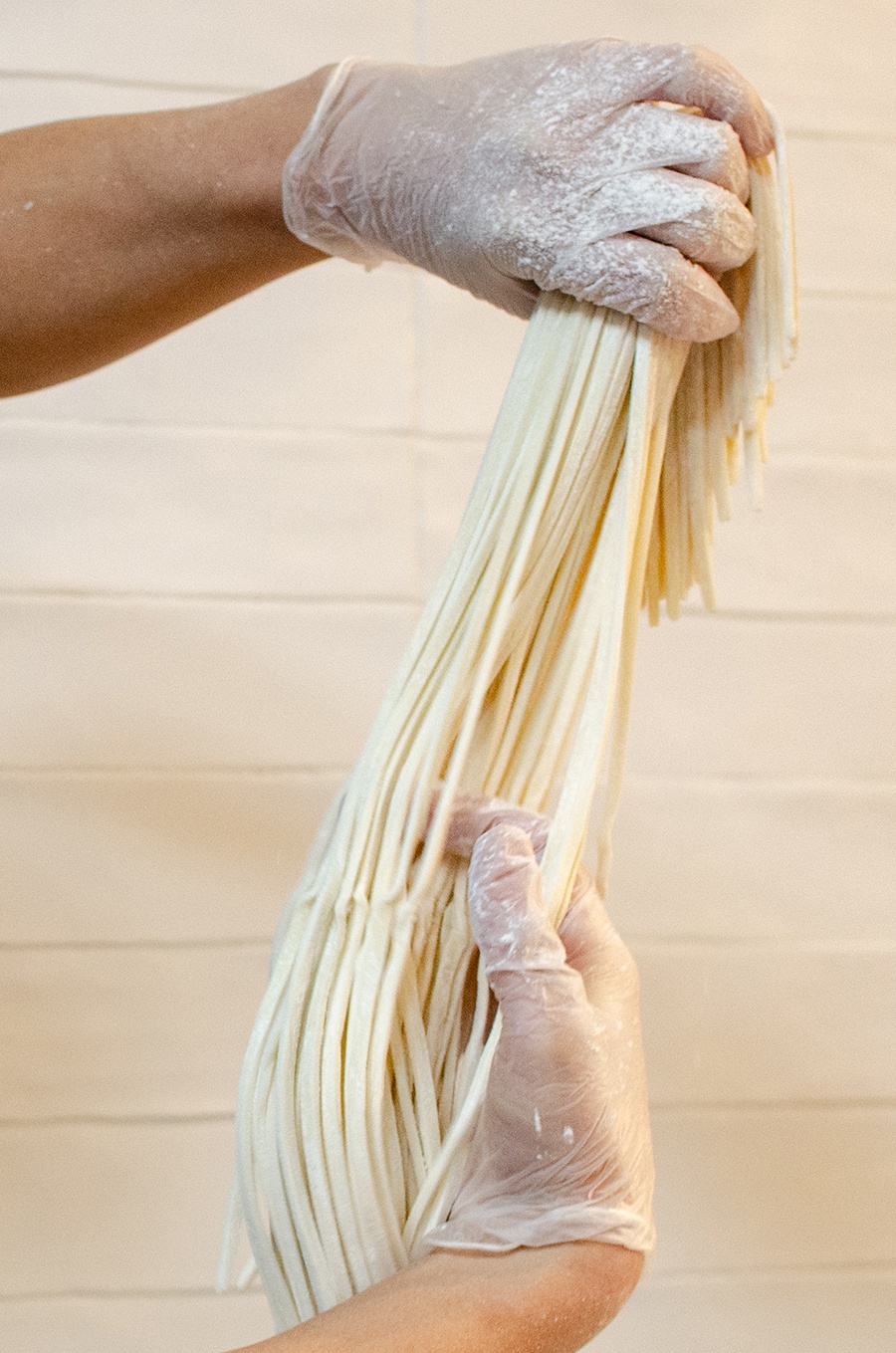Yume Ga Arukara Brings Its Supreme Udon to the Seaport
The Cambridge hit expands across the river in February, and the shiny new location will boast a larger menu and other enhancements.
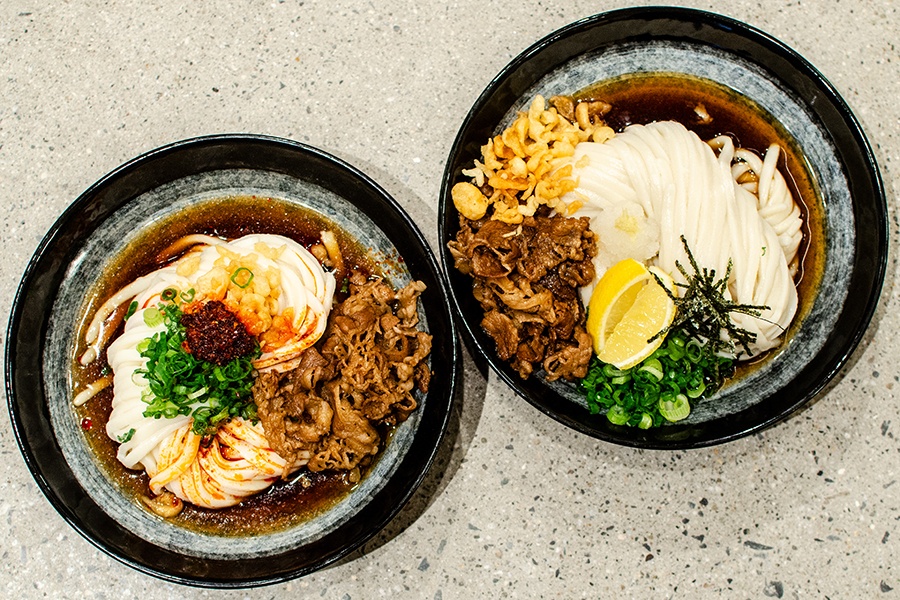
Yume Ga Arukara’s cold niku udon (spicy on the left, not spicy on the right). / Photo by Rachel Leah Blumenthal
Yume Ga Arukara, a little udon shop that makes big waves, expands from Cambridge into Boston’s Seaport District on February 19. You should probably get in line now.
When founders Tsuyoshi Nishioka and Juan Carlos Vidal opened Yume Ga Arukara in Cambridge’s Porter Square in 2017, the menu was extraordinarily simple: niku (beef) udon, $12, with the option to add extra beef and/or extra noodles. It was open for three hours (lunch) five days a week to start. Décor was minimal, aside from a hand-painted banner with the restaurant’s name. And it was hidden inside a food court of sorts, Porter Exchange, inside a Lesley University building. But the crowds descended almost immediately.
Its big sibling down the street—Yume Wo Katare, a five-year-old ramen shop (ahem, “not a ramen shop”)—already had a devoted following, after all, so it wasn’t hard to attract the attention of noodle lovers toward a second destination. (The two businesses ended their affiliation a few years ago when Nishioka moved back to Japan to focus on opening more Yume Wo Katare locations.) Long lunchtime lines quickly began forming inside Porter Exchange, with hungry customers waiting over an hour for a chance to snag a seat—all of which looked into the kitchen—and slurp thick, chewy udon noodles in a cold, umami-packed broth, adorned with thinly sliced beef, grated daikon, scallions, nori, and a lemon wedge. A Bon Appétit Best New Restaurant nod the following year only made things busier.
The original Yume Ga Arukara has carried on in much the same way since 2017, only expanding the menu slightly—you can now get hot or cold niku udon, spicy or not, or even the occasional special. The shop goes through about 100 pounds of noodles a day, says executive chef Tomohiro Shinoda, or about 300 bowls—about a 50-50 split between cold and hot udon in the winter and 80-20 in the summer.
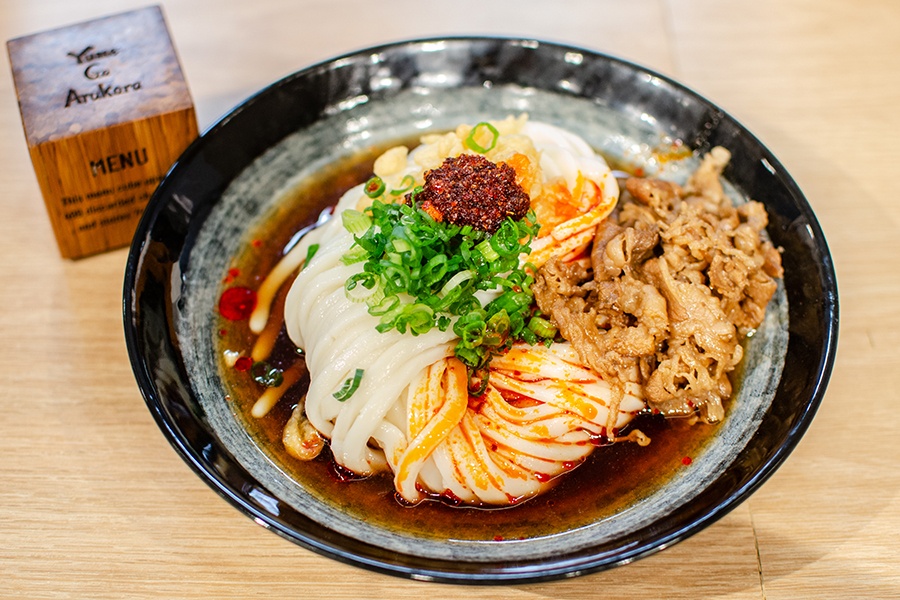
Yume Ga Arukara’s cold niku udon (spicy), featuring the restaurant’s house-made chili oil. The menu block in the background, which has a QR code, is made from recycled chopsticks by ChopValue Boston. / Photo by Rachel Leah Blumenthal
At the new Seaport location, things are going to be a little bit different—but with the same soul (and yes, the staff will still congratulate you with an “almost,” “good job,” or “perfect,” depending on how much of your bowl you finish). “We’re trying to take the core of what Yume Ga Arukara is and has always been and bring it over here in a more modern and revamped setting,” says Shinoda, including table service and a sleeker design. In Cambridge, the team had to fit operations into a quirky, already-built space, leading to the streamlined menu, whereas in the Seaport, they were able to build from scratch and play with a larger kitchen space.
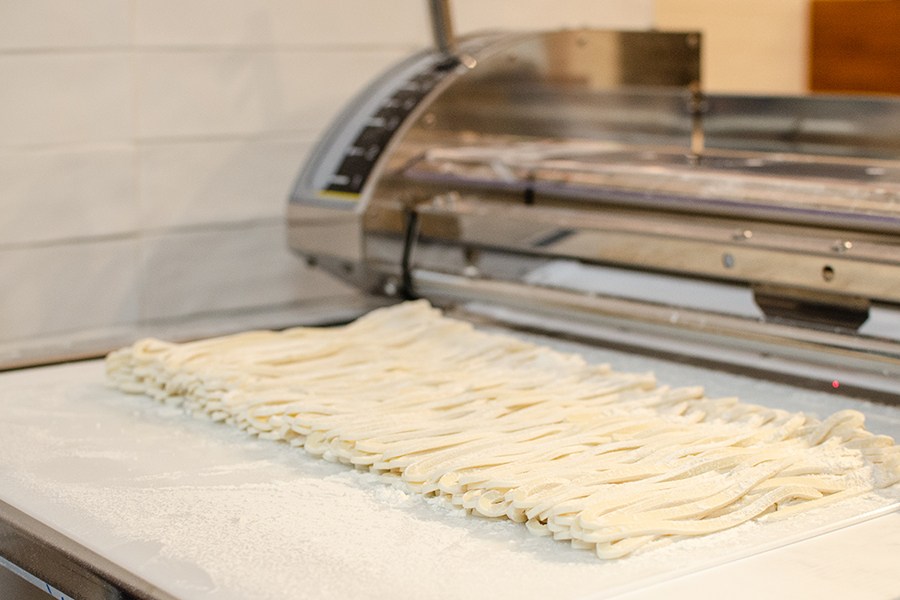
Yume Ga Arukara uses an udon machine from the Japanese brand Yamato at both locations. There are very few in the United States, says executive chef Tomo Shinoda. / Photo by Rachel Leah Blumenthal
That means an expanded menu is coming: small plates like shrimp and seasonal vegetable tempura, spicy cucumber, and agedashi tofu; more udon variations; and desserts, including cheesecake sourced from North End icon Modern Pastry. (“Japanese food and cheesecake go really well together,” says Shinoda.) There will be booze, too—a small selection of beer (mostly Japanese, but usually one local pick as well), wine, and sake. “Further down the road we want to start doing sake flights,” says Shinoda.
To start, the Seaport location will essentially stick to the Cambridge menu for a few weeks, and with limited hours. Diners will notice one new dish right away, though: a vegetarian- and vegan-friendly version of the cold udon—no beef, and the dashi broth doesn’t contain the usual fish flakes. Shinoda is working on a vegetarian version of the hot udon, too. (The non-vegetarian version of the dish mixes the standard dashi broth with a 12-hour chicken broth.)
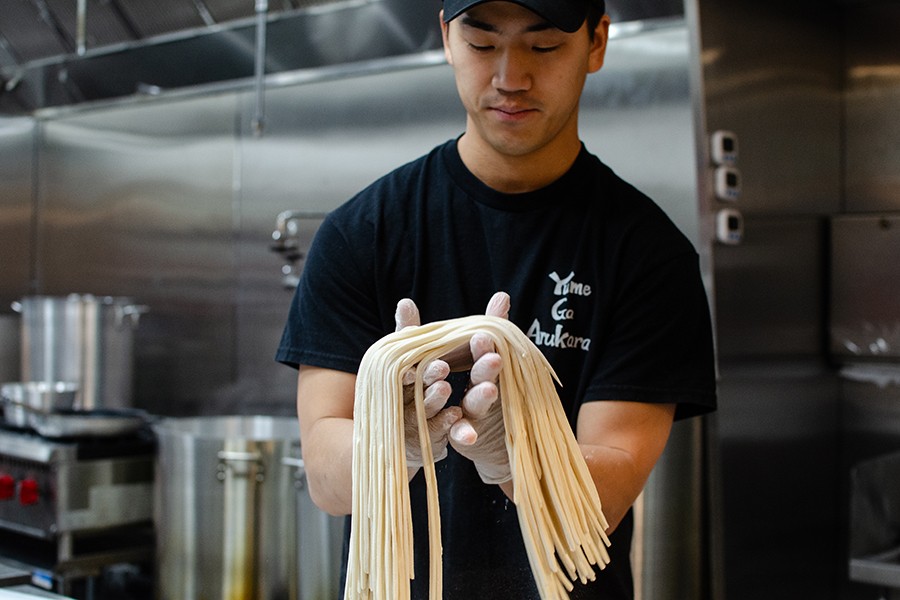
Yume Ga Arukara executive chef Tomo Shinoda holds a batch of freshly cut udon noodles in the kitchen of the new Seaport location. / Photo by Rachel Leah Blumenthal
Soon, the Seaport location will ramp up to the larger menu and more hours. Shinoda and his crew have already been testing out some of the additional udon dishes on Sundays at the original location, so he expects they’ll be available in the Seaport pretty soon. There’s the biang biang mazesoba, for example—inspired in part by the Xi’an-style hand-pulled, chili oil-spiked noodles at Gene’s Chinese Flatbread Cafe. “I realized that udon and [Gene’s] noodles are very similar,” says Shinoda, “so I kind of took a spin on that.” Yuzu shio udon will also eventually be on the Seaport menu.
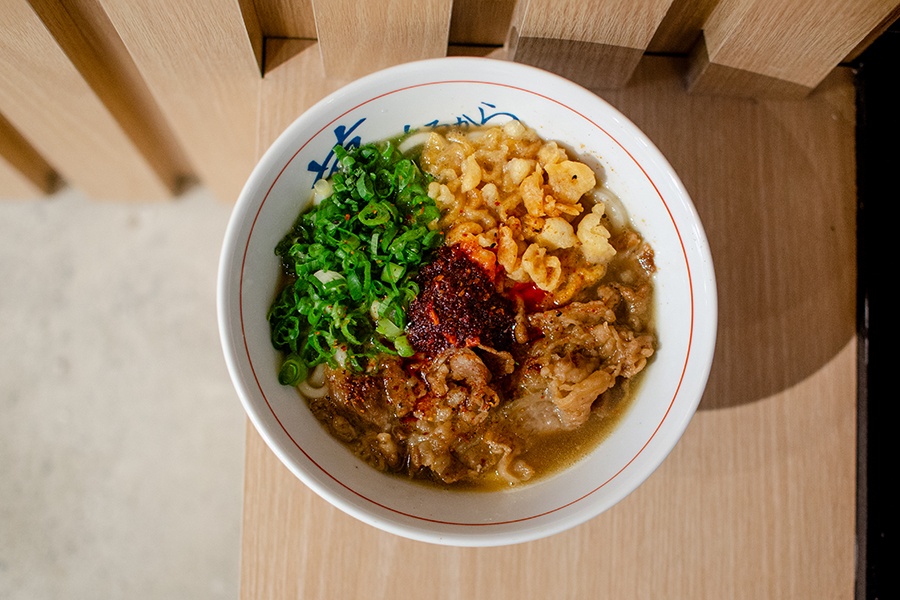
Yume Ga Arukara’s hot niku udon (spicy), featuring the restaurant’s house-made chili oil. / Photo by Rachel Leah Blumenthal
Yume Ga Arukara’s udon is the result of a labor-intensive 24-hour process. Steps include mixing the dough (a flour and saltwater mixture), curing it, pressing it, letting it rest overnight, stretching it, cutting it, boiling it for about 20 to 25 minutes, and shocking it in an ice bath before plating and serving. People tend to think the noodle-making process is the same every day, says Shinoda, but in reality, you’re constantly making adjustments, especially to the moisture of the dough, based on the weather and other variables. “What I love about making noodles is that you can always do better,” says Shinoda.

At Yume Ga Arukara in the Seaport, Tomo Shinoda rinses the starch off udon before shocking the noodles in an ice-water bath. / Photo by Rachel Leah Blumenthal
Udon is nostalgic for Shinoda, who was born in Tokyo and raised in Belmont. When he was about three years old and his family had just moved to Massachusetts, he had his first bowl of the elastic noodles. “It was my mom’s udon, and it was her way of warming us up in the winter,” he says. Years later, he tried his first bowl of Yume Ga Arukara’s udon during the recipe development phase prior to opening. “It was almost an out-of-body experience,” he says. “The texture and balance in flavor was like nothing I had ever had before, and I have been hooked ever since.”
But his noodle education started a few years prior to that. He was home in Boston on a break during freshman year of college, and Yume Wo Katare had just opened. “The portions are massive there,” he says. “I went and ate very fast. As I was walking out the door, the owner [Tsuyoshi Nishioka] asked if I wanted to work there; he said he just had a feeling.” Shinoda, who was busy with his studies in Seattle, ended up working at the Cambridge shop whenever he was home on breaks and then full-time after graduation. “That’s when I really fell in love with making noodles.”
After Yume Ga Arukara opened and Nishioka returned to Japan, Shinoda started running it and learning about udon, deepening his quest for noodle knowledge. He then ended up back in Seattle for a while, learning to make soba—Japanese buckwheat noodles—at a restaurant called Kamonegi. “It was completely by hand, no machine,” he says. “That was definitely the most fragile [noodle], and it taught me the most. So basically the track was ramen, udon, soba, and that’s kind of how people do it in Japan.” (Along the way, he also went to a two-week immersive udon school in Kagawa, Japan, an area known for udon.)
The result? As far as Cambridge (and soon Seaport) diners are concerned, an award-winning, crowd-drawing, unforgettable bowl of udon. For Shinoda, he’s always trying to get closer to a perfect noodle, which, he says, has a special snap you can feel when you bite into it. “You can only get that snap by cooking it very far, then shocking it and kind of letting it be.”
And the bigger picture: proving that Japanese food is “more than just sushi and ramen,” he says. “I want people to understand what high-quality Japanese noodles are and how good udon is. It’s Japanese soul food. It’s very comforting.”
Open starting February 19 and operating from 11 a.m. to 6 p.m. (or sell-out) for the first few weeks, with a limited menu. Expanded menu and hours coming soon; watch social media for updates. 70 Pier 4 Blvd. (The Superette), Seaport District, Boston, yumegaarukara.com.
A version of this story was published in the print edition of the April 2024 issue with the headline, “Oodles of Udon.”

